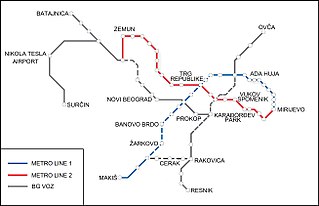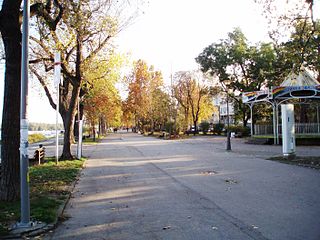
Košutnjak is a park-forest and urban neighborhood of Belgrade, the capital of Serbia. It is divided between in the municipalities of Čukarica and Rakovica. With the adjoining Topčider, it is colloquially styled "Belgrade's oxygen factory". The 1923 Belgrade's general plan, in which one of the main projects regarding the green areas was forestation of the area between Topčider and the city, envisioned a continuous green area Senjak – Topčidersko Brdo – Hajd Park – Topčider – Košutnjak, which was formed by the 1930s. This continual forested area makes the largest "green massif" in the immediate vicinity of Belgrade's urban tissue.

Ada Ciganlija, colloquially shortened to Ada, is a river island that has artificially been turned into a peninsula, located in the Sava River's course through central Belgrade, Serbia. The name can also refer to the adjoining artificial Lake Sava and its beach. To take advantage of its central location, over the past few decades, it was turned into an immensely popular recreational zone, most notable for its beaches and sports facilities, which, during summer seasons, can have over 100,000 visitors daily and up to 300,000 visitors over the weekend. Owing to this popularity, Ada Ciganlija has been commonly nicknamed "More Beograda", which was officially accepted as an advertising slogan in 2008, stylised as More BeogrADA.

Great War Island is a river island in Belgrade, capital of Serbia. It is located at the confluence of the Sava and Danube rivers. Though uninhabited, the island is part of the Belgrade City proper, and belongs to the city municipality of Zemun.

Slavija Square is a major commercial junction between the intersections of Kralja Milana, Beogradska, Makenzijeva, Svetosavska, Bulevar oslobođenja, Deligradska and Nemanjina streets in Belgrade. The square was previously named Dimitrije Tucović Square after the prominent Serbian socialist.
Ada Huja is an urban neighborhood of Belgrade, the capital of Serbia. It is located in Belgrade's municipality of Palilula.

Blokovi or Novobeogradski blokovi is the semi-formal plural name for a group of urban neighborhoods in Belgrade's municipality of New Belgrade.

Savski Nasip is an urban neighborhood of Belgrade, the capital of Serbia. It is located in Belgrade's municipality of Novi Beograd. In wider sense, the term is used for the entire left bank of the Sava on the territory of the New Belgrade, which is partially being arranged as the pedestrian "Sava quay". Since early 2010s, the term was colloquially attached to the westernmost section of the bank, the riparian zone which is threatened by the illegal construction of weekend houses in the forbidden zone.

Ušće is an urban neighborhood of Belgrade, the capital of Serbia. It is located in Belgrade's municipality of Novi Beograd. Ušće is located on the mouth of the Sava river into the Danube, thus the name. It occupies Novi Beograd's Blocks 10, 13, 14, 15 and 16 on the Sava's left and the Danube's right bank, covering a tip of land that overlooks the islands of Little War Island and Great War Island to the north and the old core of Belgrade, the fortress of Kalemegdan to the west. Ušće borders the neighborhoods of Staro Sajmište and Savograd on the south. As a compact grassy and forested area it stretches along the bank of the Danube into the Block 10, to the Zemun municipality and the Hotel Jugoslavija and the ENJUB shopping mall.

Bulevar kralja Aleksandra is the longest street entirely within the urban limits of Serbian capital Belgrade, with length of 7.5 kilometers. Known for decades after World War II as Bulevar Revolucije, it is so distinct in the Belgraders' hearts and minds that they simply refer to it as the Bulevar, although there are 20 boulevards in Belgrade.

The Belgrade Metro is a planned rapid transit system in Belgrade, Serbia currently under construction. The construction of the full metro system has been delayed repeatedly, mostly due to lack of funding. Construction of the first line began on 22 November 2021.

Savamala is an urban neighborhood of Belgrade, the capital of Serbia. It is located in Belgrade's municipalities of Savski Venac and Stari Grad.
Bara Venecija is an urban neighborhood of Belgrade, the capital of Serbia. It is located in Belgrade's municipality of Savski Venac, along the right bank of the Sava river.

Topčiderska River, or colloquially Topčiderka, or Topčiderski Creek, is a river in north-central Serbia, a 30 km-long right tributary to the Sava river to which it flows in the urban section of Belgrade. It is one of the 40 rivers, streams and creeks that flow or used to flow through Belgrade.

Branko's Bridge is the second-largest bridge of Belgrade, Serbia, connecting the city center with New Belgrade across the Sava river. Built in 1956 on the foundations of the 1934 King Alexander Bridge, which was destroyed in World War II, it reconnected Belgrade and Zemun as the only motorway bridge at the time. After several official and unofficial names, the present name stuck after the Brankova Street, which extends into the bridge from the direction of the old section of Belgrade.

Zemunski Kej is an urban neighborhood of Belgrade, the capital of Serbia. It is located in Belgrade's municipality of Zemun.

The Kalemegdan Park, or simply Kalemegdan is the largest park and the most important historical monument in Belgrade. It is located on a 125-metre-high (410 ft) cliff, at the junction of the River Sava and the Danube.

The Belgrade Main Railway Station is a former train station in Belgrade, the capital of Serbia. It was built between 1882 and 1885 according to the designs of the architect Dragutin Milutinović, and it has the status of a сultural monument of great importance. Until the opening of the new Belgrade Center station (Prokop) in 2016, it was the city's main station, and the busiest in the country. In order to free up the space for the Belgrade Waterfront project, the station was closed on 1 July 2018, and repurposed to become a museum.

The Old Sava Bridge is a 430-metre-long (1,410 ft) and 40-metre-wide (130 ft) bridge, crossing the river Sava in Belgrade, Serbia. It is the smallest road bridge in the Serbian capital and is used both for car and tram traffic. The main span between the two pillars of this tied arch bridge is over 157 m (515 ft) in length. Two bus lines and three tram lines of Belgrade public transport use the bridge.

Sugar Refinery in Čukarica or Old Sugar Factory is a defunct industrial complex in Belgrade, the capital of Serbia. Built in 1901, it was the first sugar factory in Serbia. In 1984 it was placed under protection as a cultural monument.

Belgrade, the capital of Serbia, is located on two major rivers, the Danube and the Sava which are spanned by 11 bridges in total.




















